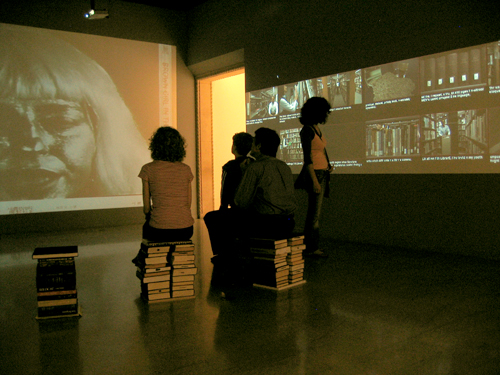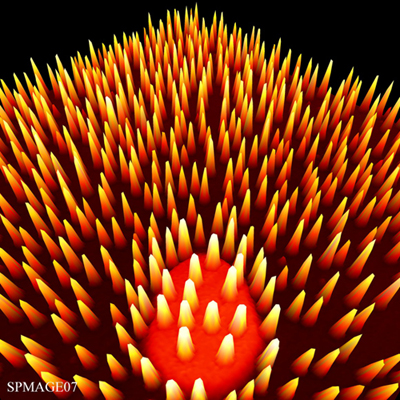“On Distributed Social Cinema and the Nano Market”, by Eduardo Navas

Adriene Jenik installation at the SDMA
Images and text source: gallery@calit2
Note: This text was written for the exhibition SPECFLIC 2.6 and Particles of Interest: Installations by Adriene Jenik and *particle group*, at gallery@calit2, from August 6 to October 3, 2008. The text outlines how dematerialization is at play ideologically and materially in contemporary life, and how it might be at play in the not so far future.
The installations “SPECFLIC 2.6” by Adriene Jenik, and “Particles of Interest” by *particle group*, on view at the gallery@calit2 from August 6 to October 2, 2008, ask the viewer to consider a not-so-distant future in which we will be intimately connected in networks not only through our computers, but also via nanoparticles in and on our very own bodies. Both projects respond to the pervasive mediation of information that is redefining human understanding of the self, as well as the concept of history, knowledge, and the politics of culture.
Information access to networked archives of books and other forms of publication previously only available in print is becoming the main form of research as well as entertainment. Access to music and video via one’s computer and phone as well as other hybrid devices has come to redefine human experience of media. From the iPhone to the Kindle, visual interfaces are making information access not only efficient in terms of time and money, but also in terms of spectacle. Accessibility usually consists of a combination of animation, video, image and text, informed in large part by the language of film and the literary novel.
Adriene Jenik, in her ongoing project SPECFLIC, currently in version 2.6, explores the evolution of film language as Distributive Social Cinema on multiple screens, from cell phone interfaces to large image projections. For the gallery@calit2, Jenik offers the public a speculative, futuristic reality that takes place in the year 2030, a time when books exist as rare objects that can only be described by the InfoSpherian, who is equivalent to the Reference Desk Librarian.
In SPECFLIC 2.6 gallery visitors can use their cell phones to share their reflections on the future of the book and the library. They are also able to sit down on specially designed stools made out of actual books, and listen to the InfoSpherian tell stories of a time when people were still able to walk into the library aisles. As Jenik envisages the year 2030, the library can only be accessed by specialist book Stackers.
The InfoSpherian has three InfoFaces: FLO, CORE, and HYPERTIA. FLO greets visitors in English, French or Spanish, and assists in accessing collections; HYPERTIA helps with books and metadata, and guides visitors throughout the InfoSphere; and CORE constantly interrupts FLO and HYPERTIA to remind visitors about security measures: to make sure that all their papers and reading permissions are in compliance with “the Software Protection Authority.” The InfoSpherian also directs the user to look at the projections on the side-walls, in which one can see the Stackers fulfilling book requests.
Inspired by the fictional writings of Jorge Luis Borges about the library, SPECFLIC 2.6 offers a plausible future when people’s access to information will be thoroughly recorded to make sure that data is consumed at a “healthy level.” Users’ activities will be monitored to ensure that people are properly contributing to the InfoSphere’s “information flow.” Jenik’s installation reflects on a future that is dependent on a network with defined boundaries modeled after, or part of, the Internet

image courtesy of *particle group*
In juxtaposition, “Particles of Interest” reflects on nanotechnology, which has no clear boundaries because it links humans to machines in ways that are beyond binary networks. Nanotechnology is an interdisciplinary field in which particles the size of one billionth of a meter are manipulated for diverse purposes. It is at the intersection of scientific research and corporate investment. Research on nanoparticles has led to the commercial development of products such as improved rubber tires, coating in glass that makes it easier to clean, as well as improved water filtration systems and sunscreen lotions, among many other innovations. In short, nanoparticles are already implemented in electronics, sporting goods, cosmetics and clothing, which means that they can be found in accessories people may use or wear as well as in lotions and cosmetics people are likely to use on their bodies.
Surprisingly, there has been little consideration of the health implications of nano-products, and to reflect on this, the *particle group* at the gallery@calit2 presents “Particles of Interest,” in which visitors can learn about the growing concern with nanoparticles in public health. In the installation visitors are invited to view videos that comment on the production of nanotechnology and to interact with sculptural devices to discover the dangers of nanoparticles on people’s skin or clothing. Through this engagement the user begins to learn of stories and incidents relevant to health concerns and conflicts in the nano market.
“Particles of Interest” appropriates and combines cultural codes of the scientific laboratory as a “clean room” and the art gallery as a “white cube” to create an aesthetic experience that reconsiders the historical links of performance and minimal art to current forms of interactivity, in sharp contrast to the authoritative, privileged position of scientific research. Art, science and technology are questioned in “Particles of Interest” in the tradition of institutional critique, meaning that the *particle group* does research inside the institutions that support nanoscience, deliberately questioning nanotechnology and its links to the commercial marketplace.
SPECFLIC 2.6 and “Particles of Interest” share a critical focus on people’s growing anxiety with dematerialization: Once the content of a book becomes part of a database, the possibilities for content re-presentation increase dramatically. Likewise, once one understands how to work with atoms, the possibilities for creating nanotechnology invisible to the naked eye, whether in lotions or microchips, also increases dramatically. Both installations offer reflexive criticism due to the fact that they are exhibited at Calit2, a research center where knowledge is constantly being redefined. The installations by Adriene Jenik and *particle group* ultimately pose important questions about the complexities of representation in art, science and technology.
Related Links
SPECFLIC http://specflic.net/
Particles of Interest http://www.pitmm.net/
Lascia un commento
You must be logged in to post a comment.








